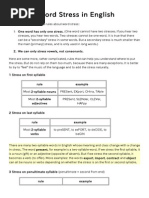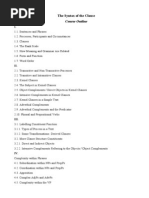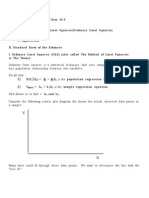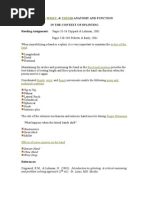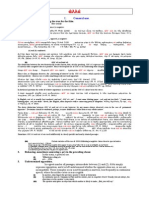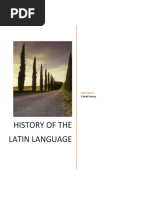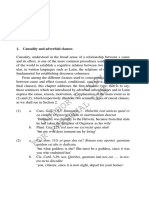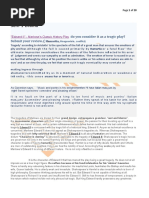0 ratings0% found this document useful (0 votes)
124 viewsThe Romance Languages
The Romance Languages
Uploaded by
PS1964scribdThis document discusses the evolution of stressed vowels in Latin and how it affected the development of Romance languages. It explains that the position of stress in a Latin word (either on the root or off the root) had crucial effects on its outcomes in Romance languages. It also discusses how Latin syllables were divided and the rule that the penultimate syllable determines stress placement in Latin words based on whether that syllable is heavy (long vowel or ends in a consonant) or light. Understanding Latin stress patterns is necessary to explain differences between related words in Romance languages.
Copyright:
© All Rights Reserved
Available Formats
Download as DOC, PDF, TXT or read online from Scribd
The Romance Languages
The Romance Languages
Uploaded by
PS1964scribd0 ratings0% found this document useful (0 votes)
124 views2 pagesThis document discusses the evolution of stressed vowels in Latin and how it affected the development of Romance languages. It explains that the position of stress in a Latin word (either on the root or off the root) had crucial effects on its outcomes in Romance languages. It also discusses how Latin syllables were divided and the rule that the penultimate syllable determines stress placement in Latin words based on whether that syllable is heavy (long vowel or ends in a consonant) or light. Understanding Latin stress patterns is necessary to explain differences between related words in Romance languages.
Original Title
The Romance Languages.doc
Copyright
© © All Rights Reserved
Available Formats
DOC, PDF, TXT or read online from Scribd
Share this document
Did you find this document useful?
Is this content inappropriate?
This document discusses the evolution of stressed vowels in Latin and how it affected the development of Romance languages. It explains that the position of stress in a Latin word (either on the root or off the root) had crucial effects on its outcomes in Romance languages. It also discusses how Latin syllables were divided and the rule that the penultimate syllable determines stress placement in Latin words based on whether that syllable is heavy (long vowel or ends in a consonant) or light. Understanding Latin stress patterns is necessary to explain differences between related words in Romance languages.
Copyright:
© All Rights Reserved
Available Formats
Download as DOC, PDF, TXT or read online from Scribd
Download as doc, pdf, or txt
0 ratings0% found this document useful (0 votes)
124 views2 pagesThe Romance Languages
The Romance Languages
Uploaded by
PS1964scribdThis document discusses the evolution of stressed vowels in Latin and how it affected the development of Romance languages. It explains that the position of stress in a Latin word (either on the root or off the root) had crucial effects on its outcomes in Romance languages. It also discusses how Latin syllables were divided and the rule that the penultimate syllable determines stress placement in Latin words based on whether that syllable is heavy (long vowel or ends in a consonant) or light. Understanding Latin stress patterns is necessary to explain differences between related words in Romance languages.
Copyright:
© All Rights Reserved
Available Formats
Download as DOC, PDF, TXT or read online from Scribd
Download as doc, pdf, or txt
You are on page 1of 2
Ti Alkire, Carol Rosen: Romance Languages: A Historical Introduction.
1. THE EVOLUTION OF STRESSED VOWELS
1.1. Syllables and word stress in Latin
1.1.1. Why word stress atters
Stress position in a Latin word (etyon) as a crucial e!!ect on its Romance outcomes (re!le"es).
Latin "nglis Italian Spanis #renc
de$ere to owe do%ere de$er de%oir
a$ere to a%e a%ere a$er a%oir
%endere to sell %endere %ender %endre
prendere to take prendere prender prendre
perdere to lose perdere perder perdre
Te Latin in!initi%es re!lect two di!!erent classes: arhi#otoni$ (stressed o!! te root: debere, habere) and rhi#otoni$
(stressed on te root: vendere, prendere, perdere). Italian preser%es te original contrast in stress pattern. Spanis as
neutrali&ed te contrast in !a%or o! ari&otonic in!initi%es. #renc, owe%er, sows te drastic conse'uences o! te
di!!erence in stress. Te stressed %owel in te ari&otonic in!initi%es gi%es (oi) *wa*, and te ri&otonic in!initi%es loose
te unstressed %owel. Tere!ore it is necessar+ to understand te Latin stress rule: te %en<iate r&le. To understand
it we need to consider tree concepts: %owel 'uantiti+, s+lla$le $oundaries, and s+lla$le lengt.
1.1.'. Latin (owels
Latin as !i%e %owels arranged in te usual triangle, wit !ront,$ack contrast neutrali&ed !or te low %owel *a*.
- . / 0
1 2 3 4
5 6
Te onl+ complication is 'uantit+ 7 eac o! tese %owels can $e eiter long or sort, a ponemic contrast seen in suc
inial )airs as: 8ST 9is: ;8<IT 9comes:
=ST 9eats: ;=<IT 9came:
Te %owel in%entor+ also includes tree diptongs, written A" *a>*, ?" *o>*, A@ *aw*, wic automaticall+ count as long
%owels. Te term di)hthon* means tat te two elements (%owel A glide) $elong to te same s+lla$le.
1.1.+. Di(idin* syllables in Latin
Te rule is: maBima&e te onset. Tis means: put as muc material as possi$le into te later s+lla$le, consistent wit te
re'uirement tat its onset must $e accepta$le as te $eginning o! a world. "Bample:
IC.DRI.CA.T@R, I<.#"R.<@ $ecause CDR, <#, R< are not possi$le onsets, and CD.R is wrong $ecause te onset is not maBima&ed.
% R , - T I - E Indicate s+lla$le $oundaries in tese Latin words:
LA.CRI.CA DAR.T" CA<.T@ D".TRA H"R.EA
?D.TI.C@ F".C"C.E"R ".T"R.<@ CA.GI.C@ (B stands !or *ks*)
Sometimes +ou encounter two ad>acent %owels in iatus. Fon:t con!use tem wit diptongsH In oter se'uences
written wit two %owel grapemes (; ;), te two %owels $elong to separate s+lla$les: SU.,.;" 9gentle:, DA.LE.,
9straw:
% R , - T I - E Indicate were te s+lla$le $oundaries !all in tese Latin words:
#".ER@.A. RI.@S H?.FI." DI.".TA.T";I.TR".@ #I.LI.A
In addition to long %owels, Latin as long (*einate) consonants !ormed $+ adding an eBtra timing unit to te closure.
Te s+lla$le $oundar+ is placed $etween te two writen consonants. "Bample: I@T.TA, ;IL.LA, etc.
@neBpectedl+, te s+lla$le $oundar+ in *s* A consonant occuring word,mediall+ runs $etween *s* and te consonant, e%en
toug *s* A consonant can $egin a word. "Bample: S%A.TA, $ut CRIS.%A (not JCRI.SDA). Tis !act is in!erred !rom clear
linguistic e%idence (K L.M.N.). Interestingl+, in some Romance languages *s* A consonant pro%ed to $e an impossi$le
onset e%en word,initiall+, !.i. in Spanis espada 9sword: ( S%ATA and escuela 9scool: ( S-H?LA (K M.L.L.).
1.1... The %en<iate R&le
?nce +ou a%e identi!ied te $oudaries o! a s+lla$le, +ou a%e to determine weter it:s ea%+ (long) or ligt (sort).
Definition: A s+lla$le is hea(y i! it consists o! two timing units. ?terwise stated, it contains a long %owel or ends in
consonant. S+lla$les meeting neiter criterion are li*ht.
% R , - T I - E In tese words +ou can:t identi!+ all te ea%+ s+lla$les unless +ou know wic %owels are long, $ut +ou can identi!+ some on sigt.
Oic onesP C@LT@ <?CT" @<F"CIC C,EL@ ,UR?RA ,UFI?
Te Denultimate Rule looks at te neBt,to,last ()en<iate) s+lla$le: I! te penultimate s+lla$le is ea%+ (long), stress it,
oterwise stress te preceding s+lla$le (te ante)en<). Te Denultimate Rule esta$lises a regular relationsip
$etween s+lla$le weigt and stress position. Ii%en Latin %owel 'uantiti+, we can deduce stress position. ;ice %ersa, i! we
know te stress position (!rom Romance re!leBes), we can deduce te weigt o! te penultimate s+lla$le in Latin. In
words containing two s+lla$les, te penultimate is stressed unconditionall+, re%ealing noting a$out %owel 'uantit+.
% R , - T I - E (Latin Romance) In te !ollowing words Latin %owel 'uantit+ is identi!ied wen long. S+lla$i!+ and sow stress.
FI#.#I.CI.L" C@.LI."R C@.LI.=.R" I<.IC.Q.C@ A.R@I.LA (R@ counts as a consonant *k
w
*)
"G."C.DL@ #?R.CQ.CA FI.R"C.T@ R?.T@<.F@
% R , - T I - E (Latin Romance) Here %owel 'uantit+ is not sown. Tr+ to in!er te stress position !rom an+ Romance re!leBes +ou ma+ know, and
!rom tat, compute te weigt o! te penultimate s+lla$le, and te %owel 'uantit+ wen possi$le.
A.CQ.CA 9!riend: ?.D8.RA 9work: <@.C8.R@ 9num$er: A.<S.CA 9soul:
LAC.T@.CA 9lettuce: CA.C8.RA 9room: CA.T=.<A 9cain: C?<.#LQC.T@ 9con!lict:
L
Ti Alkire, Carol Rosen: Romance Languages: A Historical Introduction.
I<.ST.LA 9island: #A.RQ.<A 9!lour: F?.CS.<A 9lad+:
M
You might also like
- Sardinian LanguageDocument36 pagesSardinian LanguageJesús Silva100% (1)
- Andre Du Nay - The Origins of The RumaniansDocument396 pagesAndre Du Nay - The Origins of The RumaniansMoldova.since.135967% (6)
- Introduction Into Romanian Language and CultureDocument10 pagesIntroduction Into Romanian Language and Culturechuu100% (1)
- Back To Basics GrammarDocument37 pagesBack To Basics GrammarHannah MullalyNo ratings yet
- English Renaissance DramaDocument27 pagesEnglish Renaissance DramaJhen JuanNo ratings yet
- Spanish Grammar: a QuickStudy Laminated Reference GuideFrom EverandSpanish Grammar: a QuickStudy Laminated Reference GuideRating: 4 out of 5 stars4/5 (8)
- Wave Theory of Linguistic ChangeDocument20 pagesWave Theory of Linguistic ChangeSteve Mahashabde0% (1)
- Basic English Skills Back To Basics - Let's Get It Right!: Punctuation MarksDocument4 pagesBasic English Skills Back To Basics - Let's Get It Right!: Punctuation Markslivelife01No ratings yet
- Automata Language and Computation: Unit-IiDocument34 pagesAutomata Language and Computation: Unit-IiKo VartthanNo ratings yet
- 6th Grade Course Calendarseptember2nd-5th2014Document3 pages6th Grade Course Calendarseptember2nd-5th2014api-260995515No ratings yet
- Curs Raluca GalitaDocument154 pagesCurs Raluca GalitaStan CosminNo ratings yet
- Tense, Aspect, and Verb Classes: Yesterday Homework - (DO) Before TV - WatchDocument5 pagesTense, Aspect, and Verb Classes: Yesterday Homework - (DO) Before TV - WatchDede YusufNo ratings yet
- LESSON PLAN (Teaching Part of Speech - Adjectives)Document6 pagesLESSON PLAN (Teaching Part of Speech - Adjectives)Crizette GarciaNo ratings yet
- Hooke's Law: Version: 28 Feb 06Document5 pagesHooke's Law: Version: 28 Feb 06uflillaNo ratings yet
- Elective Course: Control in English & Romanian: The Infinitive/Subjunctive DivideDocument6 pagesElective Course: Control in English & Romanian: The Infinitive/Subjunctive DivideAndrei BobeicăNo ratings yet
- Basic Italian - A Grammar and WorkbookDocument269 pagesBasic Italian - A Grammar and WorkbookBechir Saoudi100% (5)
- Guidelines For PublicationDocument4 pagesGuidelines For PublicationnincsilyenaaaaNo ratings yet
- Lec II B Urmataoarele Trei Cursuri Si Seminarele Aferente 16 Martie 2014Document25 pagesLec II B Urmataoarele Trei Cursuri Si Seminarele Aferente 16 Martie 2014trilu_lilu0No ratings yet
- Basics of SyntaxDocument9 pagesBasics of Syntaxapi-266902206No ratings yet
- IntonationDocument44 pagesIntonationAhmad AsyrafNo ratings yet
- Adverbs, AdverbialsDocument3 pagesAdverbs, AdverbialsAdelle96No ratings yet
- What Is Word StressDocument4 pagesWhat Is Word Stressminhthuc203No ratings yet
- Lucrarea de LicentzaDocument40 pagesLucrarea de LicentzaGabriel BarbarasaNo ratings yet
- English GrammarDocument39 pagesEnglish GrammarkskkingNo ratings yet
- Almond Blossom Bag 1Document25 pagesAlmond Blossom Bag 1buffylovezNo ratings yet
- Rules of StressNYYDocument2 pagesRules of StressNYYStarr BlueNo ratings yet
- Lesson Plan in English 5 2011Document137 pagesLesson Plan in English 5 2011Aseret CorduwaNo ratings yet
- A Grammar of The Greek New Testament in The Light of Historical Research Cap 10Document41 pagesA Grammar of The Greek New Testament in The Light of Historical Research Cap 10cirojmedNo ratings yet
- PortughezaDocument23 pagesPortughezaodicelNo ratings yet
- The Poisson Distribution: HistoryDocument7 pagesThe Poisson Distribution: HistoryAyush JainNo ratings yet
- Rules of Word Stress in EnglishDocument2 pagesRules of Word Stress in EnglishacerealNo ratings yet
- Consonants Students FinalDocument19 pagesConsonants Students Finaljuliotor2158No ratings yet
- Tips For Solving Analogy QuestionsDocument13 pagesTips For Solving Analogy Questionsasharma_380004No ratings yet
- Instructions For Authors and Sample Paper (12 PT Bold, Capital Letters, Centered, Two Lines Max.) (12 PT)Document3 pagesInstructions For Authors and Sample Paper (12 PT Bold, Capital Letters, Centered, Two Lines Max.) (12 PT)Costin GeruNo ratings yet
- Book Proposal - Partitives: Silvia - Luraghi@unipv - It Tuomas - Huumo@utu - FiDocument4 pagesBook Proposal - Partitives: Silvia - Luraghi@unipv - It Tuomas - Huumo@utu - FiCata CastelNo ratings yet
- A1s1 Curs 4 - Describing TrendsDocument10 pagesA1s1 Curs 4 - Describing TrendsAlexandra AdrianaNo ratings yet
- BURCHILL In-Between Spacing and The Chora in DerridaDocument12 pagesBURCHILL In-Between Spacing and The Chora in DerridaGloria Regina Carvalho AmaralNo ratings yet
- Taxation: 2001 Pre-Week Review NotesDocument49 pagesTaxation: 2001 Pre-Week Review NotesRaymond RutherNo ratings yet
- The Syntax of The Clause: Course OutlineDocument12 pagesThe Syntax of The Clause: Course OutlineDenisse ThomsonNo ratings yet
- 0 2newmicrosoftworddocumentDocument3 pages0 2newmicrosoftworddocumentGrigore AnkutzaNo ratings yet
- MUSICA5Document45 pagesMUSICA5NancyBANo ratings yet
- THDL Tibetan Reference GrammarDocument80 pagesTHDL Tibetan Reference GrammarjaumepuchadesNo ratings yet
- Handout3 26Document7 pagesHandout3 26Festus SimbolonNo ratings yet
- Iol 2005 Indiv Sol - enDocument4 pagesIol 2005 Indiv Sol - envistianNo ratings yet
- Reasoning: Takes You To Places Where You BelongDocument25 pagesReasoning: Takes You To Places Where You BelongAnonymous ZCb9xzNo ratings yet
- Biomechanics of The HandDocument20 pagesBiomechanics of The HandRobertoCastilloNo ratings yet
- Phonetics I: LAVER 1 - 2 - 3Document11 pagesPhonetics I: LAVER 1 - 2 - 3Ana Laura CermeloNo ratings yet
- Harmonic TheoryDocument49 pagesHarmonic TheoryFrank BozNo ratings yet
- Latin IIIHonors13 14Document7 pagesLatin IIIHonors13 14levanshhsNo ratings yet
- Ten and Means "Ten More Than," and - Ty, Which Means "Ten." Hundred and Thousand Are AlsoDocument3 pagesTen and Means "Ten More Than," and - Ty, Which Means "Ten." Hundred and Thousand Are AlsoArief BachrulNo ratings yet
- Good Readers and Good WritersDocument2 pagesGood Readers and Good WritersDaniel Gauna D CNo ratings yet
- Irregular Verbs in English-chart-To CustomizeDocument6 pagesIrregular Verbs in English-chart-To CustomizeAnonymous HF5fT2Tw6YNo ratings yet
- Latin and Greek Endings / PluralsDocument2 pagesLatin and Greek Endings / PluralsCatherine EbenezerNo ratings yet
- Time For Writing 2 Bat Xill Er atDocument29 pagesTime For Writing 2 Bat Xill Er atFlavius Ion NicolaeNo ratings yet
- Yearly Plan T6 Topic 4Document3 pagesYearly Plan T6 Topic 4Phoebe AngelNo ratings yet
- Assignment2 SOLUTIONFINALDocument7 pagesAssignment2 SOLUTIONFINALEduardo ArzateNo ratings yet
- Theory TranslationDocument123 pagesTheory TranslationLungu DanielaNo ratings yet
- Technical QuestionsDocument23 pagesTechnical QuestionsapamanNo ratings yet
- Allophonic Rules PDFDocument7 pagesAllophonic Rules PDFUcacue QuimicaNo ratings yet
- The Simple Essence of Dewey B Larson SDocument10 pagesThe Simple Essence of Dewey B Larson SManuel PennutoNo ratings yet
- A Comparative Vocabulary Study Guide: Spanish to EnglishFrom EverandA Comparative Vocabulary Study Guide: Spanish to EnglishRating: 1 out of 5 stars1/5 (3)
- Ācer, - Is, - e 'Scharf, Spitz' (Adj. I) Aceō, Occa, Ocris Ācrimōnia '1. Schärfe 2. (Met.) Energie, Tatkraft'Document1 pageĀcer, - Is, - e 'Scharf, Spitz' (Adj. I) Aceō, Occa, Ocris Ācrimōnia '1. Schärfe 2. (Met.) Energie, Tatkraft'PS1964scribdNo ratings yet
- Boyd-Bowman, P. - From Latin To Romance in Sound ChartsDocument13 pagesBoyd-Bowman, P. - From Latin To Romance in Sound ChartsPS1964scribdNo ratings yet
- E - Konjugation Präsensstamm: Aktiv Passiv Indikativ Konjunktiv Imperativ Indikativ Konjunktiv ImperativDocument1 pageE - Konjugation Präsensstamm: Aktiv Passiv Indikativ Konjunktiv Imperativ Indikativ Konjunktiv ImperativPS1964scribdNo ratings yet
- Denniston - The Greek ParticlesDocument4 pagesDenniston - The Greek ParticlesPS1964scribdNo ratings yet
- Bibliotheca Scriptorum Graecorum Et Latinorum TeubnerianaDocument27 pagesBibliotheca Scriptorum Graecorum Et Latinorum TeubnerianaPS1964scribdNo ratings yet
- Sorin Paliga - Earliest Slavic BorrowingsDocument23 pagesSorin Paliga - Earliest Slavic BorrowingsAdrianHarcaNo ratings yet
- ОТЗЫВDocument2 pagesОТЗЫВSardor MadaminovNo ratings yet
- 23 Lato LoW VI Europe Italic SlavicDocument22 pages23 Lato LoW VI Europe Italic SlavicNatakle c:No ratings yet
- Explanation of Ethno-Racial CategoriesDocument28 pagesExplanation of Ethno-Racial CategoriesJohnNo ratings yet
- 2007 Liviu P. Dinu, Denis Enachescu, 2007. On Clustering Romance LanguagesDocument8 pages2007 Liviu P. Dinu, Denis Enachescu, 2007. On Clustering Romance LanguagesaNo ratings yet
- Running Head: Genre Analysis: The Romance Languages 1Document7 pagesRunning Head: Genre Analysis: The Romance Languages 1api-340823348No ratings yet
- PDF A Companion To Medieval Translation ARC Companions Jeanette Beer (Editor) DownloadDocument53 pagesPDF A Companion To Medieval Translation ARC Companions Jeanette Beer (Editor) Downloadkealesawali100% (3)
- The Worlds Chief Languages (1949)Document673 pagesThe Worlds Chief Languages (1949)MikeyarnoldNo ratings yet
- The Denominations For Shepherd' and Their Derivatives in The Romance LanguagesDocument10 pagesThe Denominations For Shepherd' and Their Derivatives in The Romance LanguagesJohn MeNo ratings yet
- A Brief History of The Latin LanguageDocument9 pagesA Brief History of The Latin LanguageSōsuke Aizen100% (1)
- Copy USE Only: Causal ClausesDocument40 pagesCopy USE Only: Causal Clausesbella_anutza91No ratings yet
- Studies in The Latin of The Middle Ages and The Renaissance (1900)Document127 pagesStudies in The Latin of The Middle Ages and The Renaissance (1900)mysticmd100% (1)
- Historia de Las PreposicionesDocument113 pagesHistoria de Las PreposicionesJose Proa100% (1)
- (Cambridge Language Surveys) Rebecca Posner - The Romance Languages-Cambridge University Press (1996)Document400 pages(Cambridge Language Surveys) Rebecca Posner - The Romance Languages-Cambridge University Press (1996)Domênico Schmidt100% (2)
- Sem-1 Drama: Do You Consider It As A Tragic Play? Submit Your Review. (Document20 pagesSem-1 Drama: Do You Consider It As A Tragic Play? Submit Your Review. (Debasis ChakrabortyNo ratings yet
- Manual of Romance Phonetics AnDocument9 pagesManual of Romance Phonetics AnMonNo ratings yet
- Olinco 2014 ProgramDocument6 pagesOlinco 2014 ProgramzaalkNo ratings yet
- Roman AchievementsDocument22 pagesRoman Achievementsapi-284815070100% (1)
- Early Modern EnglishDocument15 pagesEarly Modern EnglishDH Series100% (2)
- The History of The Romanian LanguageDocument5 pagesThe History of The Romanian Languagesasdma100% (1)
- WWW - Sanet.st B01HC3N9AKDocument126 pagesWWW - Sanet.st B01HC3N9AKMRI Rasel100% (3)
- The Romance LanguagesDocument2 pagesThe Romance LanguagesPS1964scribdNo ratings yet
- 1st Handout Language Policy MA1Document7 pages1st Handout Language Policy MA1Tina ArinaNo ratings yet
- European Day of LanguagesDocument1 pageEuropean Day of LanguagesFlory DominoNo ratings yet
- Semantics and Pragmatics of False Friends: January 2012Document18 pagesSemantics and Pragmatics of False Friends: January 2012Sunhwa McLacklandNo ratings yet
- The Cambridge Handbook of Romance Linguistics (2022)Document985 pagesThe Cambridge Handbook of Romance Linguistics (2022)Carmen Mirzea Vasile100% (1)






























